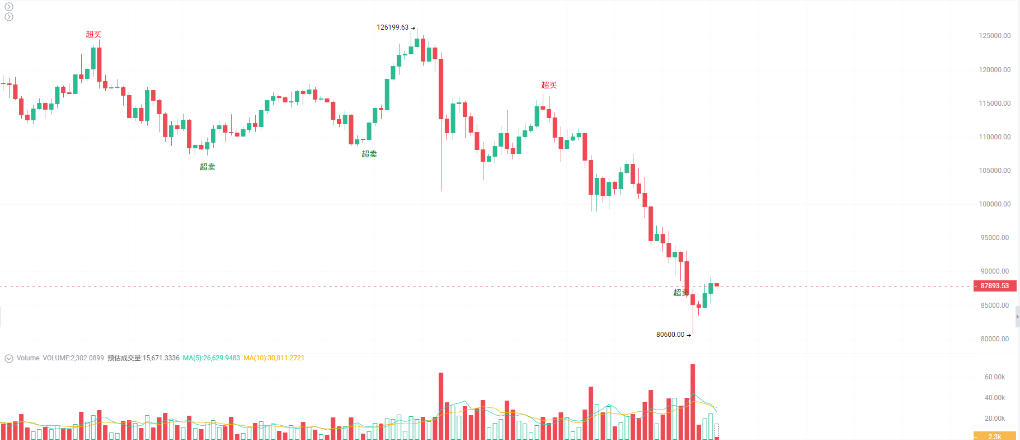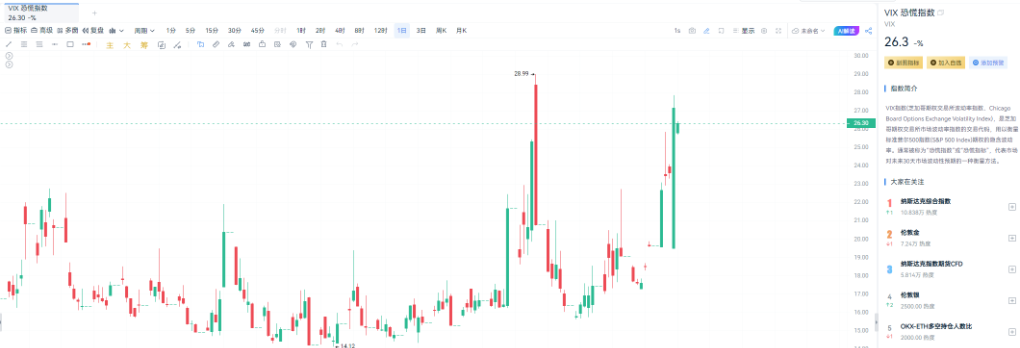After a market correction with a sharp drop of 30%, Bitcoin struggles to survive at the $90,000 mark, as Wall Street and crypto-native KOLs engage in a tug-of-war between bulls and bears.
“This is not a rebound, but the starting point of a new bull market.” Bitcoin pioneer Max Keiser stated bluntly on the X platform. On the other hand, NYDIG's global research director Greg Cipolaro warned: “Funds are truly fleeing, this is merely a technical rebound.”
As Bitcoin plummeted from a high of $126,000 to the edge of $90,000, the crypto market faced its most severe test of 2025. In this turmoil affecting global digital asset investors, market opinion leaders have profound disagreements about the future direction.

1. Market Status: Difficult Recovery After a 30% Plunge
● The crypto market in October 2025 experienced a bloody baptism. Bitcoin plummeted rapidly from the beginning of the month’s high of $126,000, hitting a low of $89,000, with a drop of up to 30%, marking the largest single-month decline of the year.

● This crash triggered a chain reaction. On October 10 alone, the total liquidation amount across the market exceeded $20 billion, with millions of leveraged traders being liquidated. Technically, Bitcoin fell below the critical support of the 200-day moving average, forming a bearish "death cross" pattern.
● “The market is undergoing a necessary deleveraging process.” NDV founding partner Jason Huang analyzed, “A short-term rebound to $98,000-$99,000 is reasonable, as a large number of short positions need to be cleared.”
● Market panic peaked in mid-October, with the fear and greed index dropping to a new low of 23 points in 2025, indicating that the market had entered the "extreme fear" zone. However, historical data shows that when this index falls below 25, it often presents a good buying opportunity for the medium to long term.

2. Bullish Views: Six Reasons to Hold onto Bull Market Beliefs
Technical Analysis Camp: Bottom Signals Have Emerged
● Fefe Demenyi, an analyst who accurately warned of the current peak, firmly stands in the bullish camp: “Now is the time to buy. My technical framework shows that market pessimism has been excessive, and the balance point between risk and opportunity has reversed.”
● Demenyi pointed out that on-chain data indicates that long-term holders (LTH) did not sell off massively during the crash; instead, a large amount of Bitcoin was transferred out of exchange wallets, which is a typical accumulation signal.
Bitcoin Extremists: Fundamentals Remain Solid
● Bitcoin pioneer Max Keiser attributed this round of decline to technical issues: “The sell-off was triggered by errors in stablecoin price printing, not fundamental problems. Current data shows signs of seller fatigue and increased buyer interest on the volume chart, indicating that the sell-off has ended.”
Keiser has consistently emphasized Bitcoin's scarcity value proposition, believing that the process of institutional adoption is merely slowing down, not ending.
Institutional Bulls: Long-term Value Is Undeniable
● Wall Street veteran analyst Tom Brienen, who accurately predicted the 2017 bull market, stated in an interview: “Every time Bitcoin corrects by more than 30%, it has been a buying opportunity in hindsight. The trend of institutional allocation to cryptocurrencies is irreversible.”
Brienen noted that most of the $65 billion in assets managed by BlackRock's Bitcoin ETF comes from pension funds and insurance capital, which will not withdraw due to short-term fluctuations.
Data Support: On-chain Indicators Show Signs of Recovery
● CryptoQuant CEO Ki Young Ju pointed out based on his platform's data: “The main reason for this round of decline was the turnover of old whales (early large holders), but the inflow of new institutional funds remains strong. The Bitcoin reserves on exchanges continue to decline, which is a positive signal.”
Macroeconomic Analysis: Liquidity Environment Set to Improve
● BitMine Chairman Tom Lee maintains his optimistic judgment: “We believe that the current cryptocurrency price cycle has not yet peaked, and the final peak may occur in 12-36 months. By the end of January next year, the target price for Bitcoin is still set between $150,000 and $200,000.”
● Lee believes that the Federal Reserve's monetary policy may shift in 2026, which will release new liquidity and drive up risk assets.
Market Structure: Deleveraging Process Nearing Completion
● DeFiance Capital CEO Arthur Hayes previously pointed out that Bitcoin's decline was due to a contraction in dollar liquidity, but his view has recently changed: “The market's deleveraging process is more than halfway complete, and the darkest hour may have passed.”
Hayes stated that while there are still structural flaws in the crypto perpetual contract market, this crash has cleared most of the excessive leverage.
3. Bearish Views: Five Signals to Watch for a Bear Market
Cycle Theory Camp: Four-Year Cycle May Have Failed
● Jan van Eck, CEO of VanEck, made a shocking statement in a recent interview: “The four-year cycle of Bitcoin may have been broken, and 2025 could potentially be a down year. Based on historical patterns, we predict that 2026 may see a bear market.”
● This view has been echoed by some analysts with traditional financial backgrounds. Paul Howard, senior director of Wincent Investment Management, bluntly stated: “Bitcoin may have peaked in 2025, and the market will enter a phase of slowing growth, narrowing volatility, or even prolonged sideways movement.”
Capital Flow: ETF Inflows Turn to Outflows
● NYDIG global research director Greg Cipolaro pointed out the most critical issue: “The positive feedback loop that drove the previous rise has reversed. Bitcoin ETFs have shifted from a capital inflow engine to large-scale net outflows, which is a true capital flight.”
Since October, U.S. spot Bitcoin ETFs have seen net outflows for three consecutive weeks, totaling $4.5 billion, contrasting sharply with the continuous inflows in the first half of the year.
Leverage Liquidation: Market Structure Remains Fragile
● CNBC commentator Jim Cramer analyzed from a traditional financial perspective: “A significant driver of this round of decline was the chain liquidation caused by high leverage in the market. Despite experiencing significant deleveraging, the market structure remains fragile.”
● Cramer warned that if Bitcoin falls below the $90,000 mark again, it could trigger a new wave of liquidations, with prices potentially testing the $85,000 support.
Macroeconomic Factors: Federal Reserve Policy Continues to Apply Pressure
● Placeholder VC partner Chris Burniske issued a warning on social media: “Beware of the ‘rise-FUD disappears-then crash’ cycle. The market seems to be brewing a rebound, but when everyone starts shouting bull market, the next round of crashes may not be far off.”
● Burniske believes that the Federal Reserve may maintain high interest rates longer than the market expects, which will continue to pressure risk assets.
Market Sentiment: Community Confidence Severely Undermined
● Crypto commentator Adrian pointed out: “Compared to previous cycles, there is a more pronounced sense of fatigue and skepticism on social media right now, feeling that this cycle is ‘more over.’” The volume of mentions and interactions on crypto social media dropped by 40% in October, indicating a significant cooling of retail interest.
4. Institutional Game: Cautious Layout of Traditional Finance
● In this tug-of-war between bulls and bears, traditional financial institutions exhibit complex positions. On one hand, Bitcoin ETFs from institutions like BlackRock and Fidelity are seeing capital outflows; on the other hand, more institutions are quietly laying out blockchain infrastructure.
● Harvard University increased its Bitcoin ETF holdings to $442.8 million, making it the largest single holding in its portfolio, even surpassing major tech stocks. This move demonstrates top educational institutions' long-term confidence in cryptocurrencies.
● Mathew McDermott, head of Goldman Sachs' digital assets division, privately stated: “We tell clients that allocating 1-3% of their portfolio to cryptocurrencies is a reasonable hedging strategy. Despite short-term volatility, the disruptive potential of blockchain technology cannot be ignored.”
● Meanwhile, the Bitcoin allocation on corporate balance sheets continues. As of November 2025, MicroStrategy holds over 214,000 Bitcoins, and the company's executive chairman Michael Saylor firmly stated: “Bitcoin is a productive capital asset, and our financial structure can withstand significant price declines.”
5. Three Key Factors Determining Market Direction
Macroeconomic Monetary Policy: Federal Reserve's Interest Rate Path
● The direction of the Federal Reserve's monetary policy remains the most crucial factor determining the fate of the crypto market. The CME FedWatch tool shows that the market currently expects a 70%-81% probability of the Federal Reserve cutting interest rates in January 2026.
Bitwise Chief Investment Officer Teddy Fusaro stated: “If the Federal Reserve turns dovish, it will release a large amount of liquidity, which is the biggest boon for Bitcoin and the entire crypto market.”
Regulatory Environment: Policy Changes After the U.S. Election
● Coinbase CEO Brian Armstrong announced that the legislative work on the crypto market structure bill is “90% complete,” and the restrictive clauses on DeFi in the draft have been removed. This marks a shift from passively adapting to actively participating in rule-making for the industry.
Satoshi Action Fund CEO Dennis Porter emphasized: “Once the crypto market structure legislation is passed, it will open the ‘floodgates’ for capital, greatly boosting Bitcoin's rise.”
Technological Development: Supply and Demand Relationship After Bitcoin Halving
● Although the next Bitcoin halving is not expected until 2028, the market has already begun to pay attention to the impact of this event. Historical data shows that within 12-18 months after a halving, Bitcoin prices typically see significant increases.
● Crypto analyst Lark Davis pointed out: “The issuance rate of Bitcoin will continue to decline, while potential demand is increasing. This supply-demand imbalance is the fundamental reason for being bullish on Bitcoin in the long term.”
In a Wall Street trading room, senior trader Mark lamented: “Unlike the 2021 cycle, this time we see a more mature market structure—more institutional participants, a more complete regulatory framework, and stronger underlying infrastructure.”
At a crypto investment conference in New York, traditional fund managers were privately discussing allocation strategies. One fund manager, who wished to remain anonymous, admitted: “We are waiting for two signals: a clear interest rate cut signal from the Federal Reserve and a re-inflow of funds into Bitcoin spot ETFs.”
The complex machine of the crypto market is seeking a new balance amid the tug-of-war of various forces.
Join our community to discuss and become stronger together!
Official Telegram community: https://t.me/aicoincn
AiCoin Chinese Twitter: https://x.com/AiCoinzh
OKX benefits group: https://aicoin.com/link/chat?cid=l61eM4owQ
Binance benefits group: https://aicoin.com/link/chat?cid=ynr7d1P6Z
免责声明:本文章仅代表作者个人观点,不代表本平台的立场和观点。本文章仅供信息分享,不构成对任何人的任何投资建议。用户与作者之间的任何争议,与本平台无关。如网页中刊载的文章或图片涉及侵权,请提供相关的权利证明和身份证明发送邮件到support@aicoin.com,本平台相关工作人员将会进行核查。




